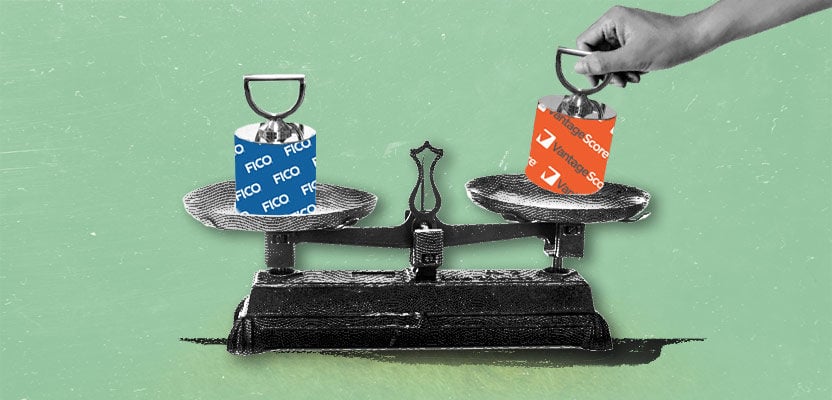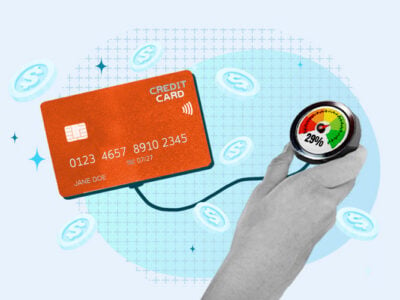While most lenders continue to use FICO, it’s important to know that your FICO score isn’t your only credit score. Many online credit score checking services now partner with VantageScore, a different credit-scoring company from FICO. But is there really a big difference?
Table of Contents
What’s the difference between FICO and VantageScore?
The differences between FICO and VantageScore are fairly small because their scoring models are similar. By and large, they consider the same factors when calculating your credit score. They weigh these factors slightly differently, but their models both reward and penalize the same behaviors.
There are four major differences between FICO and VantageScore:
1. Minimum credit scoring requirements
FICO and VantageScore differ in terms of the length of credit history that you need to have before they’ll generate a credit score for you.
In order to get a FICO score, you need to have a credit account that’s at least six months old, and you need to have at least one account that’s been reported to one of the credit bureaus in the past six months.1
By contrast, VantageScore generates your score more quickly after you open your first account (as quickly as one month afterwards, according to some sources).2 3
Moreover, as long as one of your lenders has reported your account information to one of the credit bureaus at least once in the past two years, VantageScore will continue to produce a credit score for you.
2. Score ranges and classifications
The early VantageScore models had a range of 501 to 990, but the newer models (VantageScore 3.0 and VantageScore 4.0) have the same scoring range as FICO (300 to 850). 1 4
However, it’s still hard to compare credit scores from FICO and VantageScore because the two companies use different thresholds between score classifications. For example, a FICO score of 790 is classed as “very good,” whereas the same score is classed as “excellent” by VantageScore. We’ve listed the ranges for FICO and VantageScore below:
| FICO/VantageScore Rating | FICO Score Range | VantageScore Range |
|---|---|---|
| Exceptional/Excellent | 800–850 | 781–850 |
| Very Good/Good | 740–799 | 661–780 |
| Good/Fair | 670–739 | 601–660 |
| Fair/Poor | 580–669 | 500–600 |
| Poor/Very Poor | 300–579 | 300–499 |
3. How scores differ between bureaus
FICO produces separate scoring models for each of the three credit bureaus (Experian, Equifax, and TransUnion), whereas all three bureaus use the same VantageScore model. 5 6
This means that if all three of your credit reports (produced by the three credit bureaus) are identical, then you’ll have the same VantageScore for each, but not necessarily the same FICO score.
However, your credit reports may not be identical because many lenders don’t report to all three bureaus. In reality, all of your FICO and VantageScore credit scores will likely vary to a small degree.
4. Scoring factors and weightings
FICO and VantageScore weight the factors that affect your credit score differently, as shown in the tables below:
| Payment History | Amounts Owed (Credit Utilization) | Length of Credit History | Credit Mix | New Credit | |
|---|---|---|---|---|---|
| FICO | 35% | 30% | 15% | 10% | 10% |
| Payment History | Credit Utilization | Depth of Credit | Recent Credit | Balances | Available Credit | |
|---|---|---|---|---|---|---|
| VantageScore 3.0 | 40% | 20% | 21% | 5% | 11% | 3% |
| VantageScore 4.0 | 41% | 20% | 20% | 11% | 6% | 2% |
Moreover, FICO and VantageScore treat the data points that influence these categories in different ways. For example, there are significant differences in how they treat hard inquiries and collection accounts, which is why you are likely to have different credit scores in each model.
Collection accounts
A collection account is a severely overdue debt that your creditor has charged off and sent to a debt collection agency. FICO and VantageScore both ignore small collection accounts, but larger ones can severely damage your credit score.
However, FICO and VantageScore have different minimum thresholds required for collection accounts to be factored into your score. VantageScore 3.0 and 4.0 exclude collection accounts that are worth less than $250, whereas FICO 8 and FICO 9 only ignore collections worth less than $100. 7 8
Hard inquiries
When you apply for a loan or credit card, your lender will usually conduct a credit check called a hard inquiry, which will lower your credit score by around five points. 9
Fortunately, the credit scoring models count multiple hard inquiries as a single inquiry if they appear on your credit report within a certain time period. FICO offers a 45-day grace period in their newer models, whereas VantageScore only offers a 14-day grace period. 3
Be aware that this grace period only applies to hard inquiries from loan applications of the same type. This means that three car loan inquiries will count as one, but one auto loan inquiry and one mortgage inquiry will be treated as two separate inquiries.
Moreover, FICO only applies this grace period to mortgages, auto loans, and student loans, whereas VantageScore applies it to other types of credit, including credit cards. 10 11
Why is my VantageScore lower than my FICO score?
It’s normal for your VantageScore and FICO credit scores to be different because they’re calculated using different scoring algorithms.
For example, your payment history accounts for 5%–6% more of your credit score in the VantageScore models than in the FICO models, so your VantageScore will likely take a harder hit if you fall behind on payments.
On the other hand, if you have a debt worth more than $100 but less than $250 that’s been sent to collections, your credit will take a major hit in FICO’s models but not in the VantageScore models.
FICO score vs. Credit Karma: why your scores are different
Credit monitoring services like Credit Karma monitor your credit scores, but they don’t create them. Your FICO score will be different from the score Credit Karma gives you because Credit Karma only provides you with your VantageScore.
VantageScore-to-FICO score conversion calculator
Unfortunately, there isn’t a reliable VantageScore-to-FICO score conversion calculator because the companies use different algorithms to calculate your credit score, and those algorithms are proprietary (which means they’re kept secret).
However, you can check your FICO score for free from your lender or credit card issuer if they’re enrolled in the FICO Score Open Access program. You can also go to VantageScore’s website to see if you can get your credit score from one of their partners. Alternatively, you can sign up for credit monitoring services with each of the main credit bureaus to monitor your credit scores.
Takeaway: FICO and VantageScore produce credit scoring models based on similar factors, with some small differences.
- FICO and VantageScore models calculate your credit score based on similar factors, and they use the same credit scoring range of 300 to 850. However, they have different weightings for these factors.
- To generate a credit score, FICO requires you to have an open credit account for six months, whereas VantageScore only requires you to have an account for one month.
- VantageScore ignores collection accounts worth less than $250, and FICO ignores collection accounts worth less than $100.
- FICO has a 45-day grace period in which multiple hard inquiries for loan applications are treated as one. By contrast, VantageScore only offers a 14-day grace period, but they also treat multiple hard inquiries for credit card applications as a single hard inquiry.
- You can’t convert your VantageScore into a FICO score because they’re based on different scoring algorithms, and the details of those algorithms are proprietary (private).







